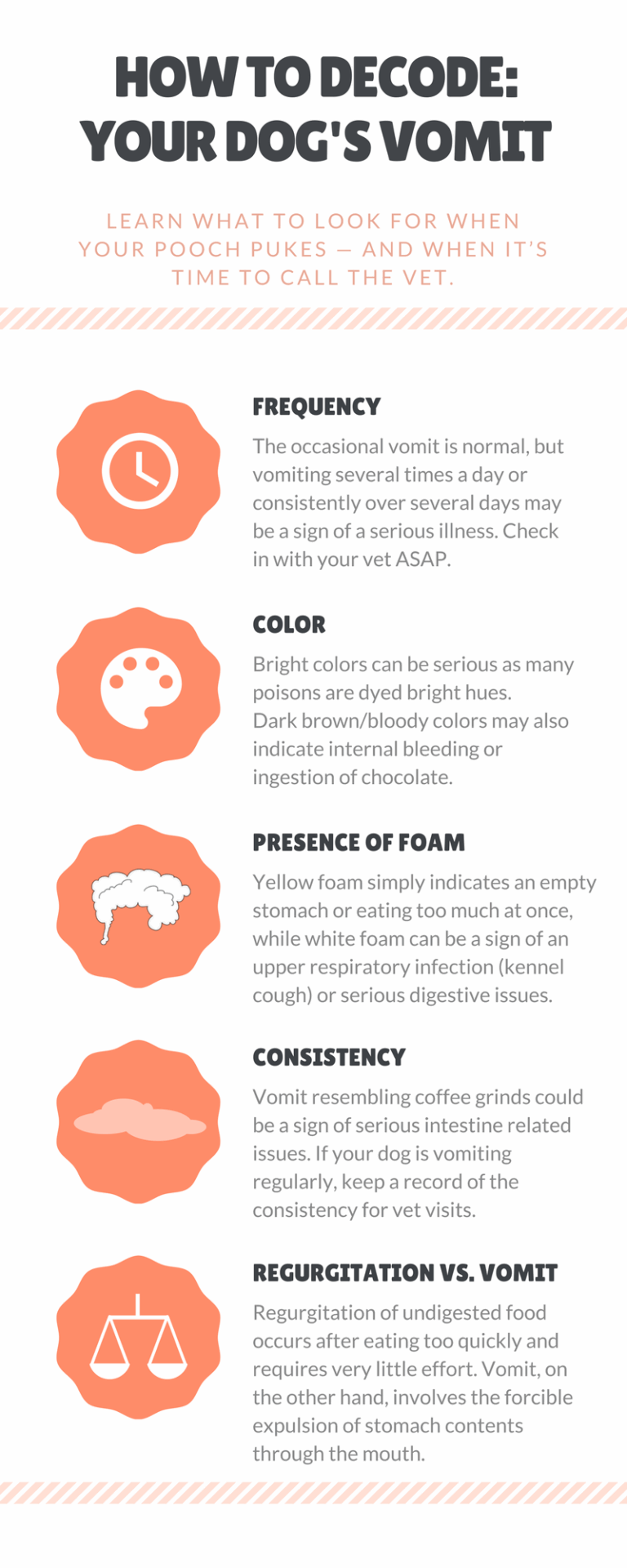If your dog vomits after eating, your job is to do more than clean it up. You need to look at the vomit itself, along with your dog’s behavior around when the incident took place, for clues about what might have caused them to throw up. Take note of the vomit’s color and texture, how long after eating it took place, and any other signs your dog is giving that they might be in pain or otherwise feel unusual. You might also want to take a photo or collect a sample to bring to a veterinarian. Below, you’ll find some tips on what specifically to look for and how to help your pup feel their best.
While every dog vomits from time to time, and one single vomiting incident may not be a big deal, if your dog vomits repeatedly or you see signs of blood it’s best to go to the veterinarian as soon as you can to get them checked out (read more on decoding vomit here).
The difference between vomiting and regurgitation
Vomiting occurs when food–and maybe something else–that’s reached your dog’s stomach comes up. It involves the use of your dog’s stomach muscles, and will usually be preceded by signs like retching, lip-licking, heaving, gagging, excessive swallowing, or drooling. It will be partially digested, and might be accompanied by bile or other materials and substances that were in your dog’s stomach.
Regurgitation, on the other hand, comes directly from the esophagus. It tends to happen more quickly than vomiting, without those warning signs, and what comes out won’t be digested or contain bile or stomach acids. Vomiting and regurgitation are not the same thing, but if either one happens frequently you should bring your pup to a vet. Regurgitation may not be anything serious–your dog could have just gotten a little food stuck in their throat and tried to get it out of their body–but it can sometimes be a sign of conditions that require treatment, including some that are life-threatening. If there’s any doubt, it’s better to be safe than sorry.
Possible causes of vomiting after eating
Vomiting, too, can occur for reasons ranging from mildly concerning (a change in diet) to potentially life-threatening (kidney or liver failure). Here are some of the most common, and what to do about them.
Eating too much, or too quickly
Just like people, dogs who eat too much or too quickly might throw up. If this is the cause of your dog’s vomiting, the fix is simple: help them eat more slowly. One solution is to use a slow feeder or a puzzle bowl. Not only can a puzzle bowl slow a dog’s eating down–it’s also a great way to provide some mental exercise for your pup.
In some circumstances, you might want to consider feeding your dog more meals throughout the day, with smaller portions of food in each.
A pre-portioned plan could help a dog who’s overeating–if you know exactly how much to serve at each mealtime to meet your pup’s caloric needs, that can eliminate some guesswork and uncertainty on your part.
Finally, if you have more than one dog, they may be eating quickly because they feel that they need to compete for food. Try feeding them separately to avoid this issue.
Change in diet
If you change your dog’s diet suddenly, they may experience digestive issues that can include vomiting. If you’re switching your dog’s food, have a plan for a smooth transition. If you’re not sure what to do, and especially if your dog has any health conditions, consult with your veterinarian about the best way to handle a shift in your dog’s diet.
Allergy or food intolerance
Certain ingredients in food could cause dogs to vomit, and might also cause other problems like diarrhea. If this is the case, changing their diet may be a good idea. Choosing a complete and balanced, fresh food might help–ultra-processed kibbles can contain a raft of ingredients that aren’t even directly listed on the bag, and could cause digestive distress. If you suspect that your dog has an allergy or a food intolerance, talk to their veterinarian about the safest way to help them.
Dietary indiscretion or poisoning
Dogs who eat grass or other things they’re not supposed to eat–whether they’re not foods at all, or simply foods that dogs should not eat–may vomit as their body attempts to remove the undesirable material from their system. A little grass on its own may not usually harm your dog, but it can contain parasites, pesticides, and other dangerous items or substances that would require medical attention.
Some items that may be in your own home, like grapes, chocolate, and xylitol, are very dangerous to dogs if ingested. If your dog has any of these, call a vet right away and make sure they receive the treatment they need. Don’t delay, because in some cases these foods can be deadly.
If you’re not sure what your dog ate, and they vomit or show other signs of distress, take them to the veterinarian to make sure nothing is seriously wrong.
Stress and anxiety
If you’ve ever been so nervous that you felt nauseated, you know how powerful that feeling can be. Dogs get it sometimes, too. If your dog is under stress–from separation anxiety, changes to their routine, or any other change in their life–try to address that underlying issue. Whether or not it’s what’s causing your dog to throw up, stress is not good for your dog’s overall health and it’s best to reduce it as much as possible.
Bloat, or Gastric Dilatation-Volvulus (GDV)
Vomiting and unproductive belching are among the signs of this life-threatening ailment. Dogs with bloat will also often have a distended belly; rapid, shallow breathing; or pale gums. If you see any signs of bloating, bring your dog to a vet right away. It’s an emergency in which minutes can make the difference between survival and death.
Ingestion of a foreign object
Dogs are notorious for eating things that are inedible and indigestible. If your dog has done so, they may vomit after their next meal in an attempt to rid their stomach of the foreign object. Even if your dog does vomit, it’s still vital that you take them straight to the vet to make sure that there’s nothing causing a blockage or further damage to their body. Don’t assume that they’ll just pass it, as it could be too late to help once you realize the situation is more serious than you thought it was.
Viral or bacterial infection
Gastroenteritis, or the inflammation of the intestinal tract, can be caused by viruses or bacteria. Among the common symptoms of this issue are vomiting and diarrhea. With this condition, you may see foam or bile in your dog’s vomit, and they may run a fever. If you suspect that your dog has gastroenteritis, visit the veterinarian and discuss treatment options. Once the infection is gone, the vomiting should stop.
Another underlying health issue
In some cases, vomiting after eating can be a sign of a more serious health problem like an autoimmune disease, kidney or liver failure, or pancreatitis. If your dog is vomiting and you can’t determine the cause, you should take them to the vet.
How to soothe your dog’s stomach if they’re vomiting
There’s no substitute for veterinary advice–but, while you’re waiting to hear back from them, if your dog is having trouble holding down food, you can withhold food for up to 6 to 12 hours. Don’t withhold water, though–a dog who’s been throwing up is especially prone to dehydration, and, in fact, vets often provide intravenous fluids as part of their treatment of a dog who’s been throwing up. You might also temporarily feed your dog a bland diet of items like unseasoned cooked chicken and white rice, slowly transitioning back to their usual food.
The bottom line
While the cause of your dog’s vomiting might not be serious, your dog shouldn’t be vomiting after eating–so don’t just ignore the problem. If the cause of your dog’s vomiting is obvious, you can try to make the necessary adjustments on your own. However, if you have no idea why your dog is vomiting, you need to visit your vet. This is especially important if you notice other symptoms like diarrhea, weight loss, decreased appetite, blood in their stool or vomit, lethargy, and lip-licking. Any of these could be signs of a more serious underlying health condition.










